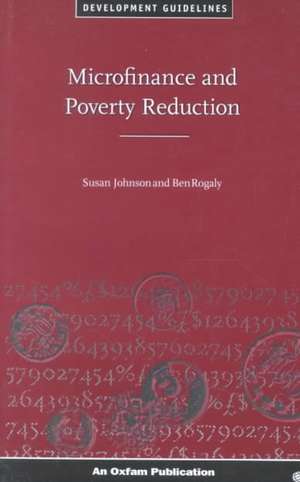Microfinance and Poverty Reduction: Oxfam Development Guideline
Autor Susan Johnson, Ben Rogalyen Limba Engleză Paperback – 31 oct 1997
Preț: 175.65 lei
Nou
Puncte Express: 263
Preț estimativ în valută:
33.62€ • 36.53$ • 28.26£
33.62€ • 36.53$ • 28.26£
Carte disponibilă
Livrare economică 31 martie-14 aprilie
Preluare comenzi: 021 569.72.76
Specificații
ISBN-13: 9780855983697
ISBN-10: 0855983698
Pagini: 134
Dimensiuni: 146 x 212 x 9 mm
Greutate: 0.22 kg
Editura: OXFAM PUB
Seria Oxfam Development Guideline
ISBN-10: 0855983698
Pagini: 134
Dimensiuni: 146 x 212 x 9 mm
Greutate: 0.22 kg
Editura: OXFAM PUB
Seria Oxfam Development Guideline
Notă biografică
Susan Johnson lectures in international development at the University of Bath, and was previously with ActionAid. She is co-author of a widely cited book on microfinance and poverty, and sits on the editorial committee of the Small Enterprise Development Journal. Her most recent research and publications are on gender, the evolution of financial markets and microfinance in East Africa.
Cuprins
* Acknowledgements; * Introduction; 1. Current debates in microfinance; * Subsidised credit provision; * The move to market-based solutions; * Making use of social collateral; * Savings Can microfinance interventions reduce poverty? o Poverty as powerlessness; o Credit for micro-enterprises; o Reaching the poorest; * Financial interventions and social change; * Treading carefully in microfinance interventions; 2. Informal financial services; * Introduction User-owned informal financial services; o Some examples of user-owned financial services; * Turning the informal into the formal; * What can be learned from informal finance? * Deciding when and how to intervene; o Research questions on existing informal financial services; * Filling the gaps; o Some examples of innovative services; * Promotion: an alternative strategy for NGOs; o Formation of savings groups and development of internal credit facilities; o Promotion of small-scale formalised approaches; o Linking groups to the formal system; o Linking with specialised financial service NGOs; o Advocacy; * Summary and conclusions; 3. The design of savings and credit schemes for poor people; * Introduction; * Targeting savings and credit to poor people; * Women as users of financial services; * Lending through groups; o Functions of the group in microfinance schemes; o Including the poorest; o Other examples of group-based schemes; * Savings; o The value of savingd facility; o Compulsory or valuntary savings? o Linking savings to credit; * Forms of loan; o Credit in cash or kind? o Directed or undirected credit? * Loan disbursement and repayment schedules; * Interest rates; * Integrating financial services with other activities; 4. Savings and credit group formation and institution-building; 5. Social development programmes; 6. Economic development activities; 7. Summary and conclusion; 8. Financial performance and sustainability; * Introduction; * Managing and assessing financial performance; o The repayment rate; o Arreas and default; * Financial sustainability; o The pros and cons of 'scaling up; o Issues in sustainability: the experience of 'village banking'; o Sustainability through exstending coverage; o Measuring financial sustainabilty; * Managerial and organisational sustainability; o The role of staff in microfinance interventions; o Organisational sustainability and change; * Summary and conclusions; 9. Assessing impact; * Introduction; * The difficulties of assessing impact; o Establishing loan use; o Measuring change: controls and baselines; o Proving causality; * Innovations in impact assessment; o Researching usefulness: a case study; o Assessing impact on social relationships; o Impact assessment as a dynamic process; o Validating quantitative data in impact assessment; o Using quantitative data in impact assessment; * Learning and adaptability; * Summary and conclusions; 10. Case studies; * Introducing the case studies; * Union Regional de Apoyo Campesino (URAC), Mexico; o Background; o Design; o Financial performance and sustainability; o Impact assessment; o Conclusions; * SUNGI Developent Foundation, Pakistan; o Background; o Design; o Financial performance and sustainability; o Impact assessment; o Conclusions; * Ladywood Credit Union, UK; o Background; o Design; o Financial performance and sustainability; o Impact assessment; o Conclusions; * ACTIONAID in The Gambia; o Background; o Design; o Financial performance and sustainability; o Impact assessment; o Conclusions; * Casa Campesina Cayambe, Ecuador; o Background; o Design; o Financial performance and sustainability; o Impact assessment; o Conclusions; * Conclusions; * Annex 1 Table 1 Six microfinance institutions; * Annex 2 Repayment rate and arrears rate; * References
